12 years ago, I was in a class I will never forget. We were asked to sit back, relax, and watch a movie—Blade Runner.
But it wasn’t a random movie we were asked to watch for fun. This was part of the urban design course we were doing. We were asked to watch the movie to do what we were there for, study cities by observing how the film depicted a city. This was a class unlike any I had attended so far, and it left me inspired to learn more about cities and work on urban projects going forward. This deviation from conventional ways of teaching—where professors usually just tell students things—is why I still remember this class and what I learnt in it, even a decade later.
I also learnt that this is what teaching is about—finding new ways to inspire, to transfer knowledge, and most importantly, to get that knowledge to stick in people’s minds.
Today, I am part of the team at ITDP India that’s been working for more than two decades on building the capacity of city officials in planning and implementing sustainable mobility initiatives.
Over the years, we’ve been testing various methods to do this, like workshops, presentations, toolkits, templates, study tours, hands-on exercises. We’ve learnt from these tests, and scaled up the effective ones.
In 2020, we launched two national programmes with the Government of India’s Smart Cities Mission—the India Cycles4Change and Streets4People Challenges—aimed at building the capacity of officials from over 100 cities to create Healthy Streets. Through the Challenges, we’ve developed over 100 toolkits and conducted over 35 workshops over the last three years.
As part of the programmes, we wanted cities to create a realistic three-year action plan towards implementing Healthy Streets—which would include building the right institutional support for it and conducting campaigns to encourage a behaviour change among people to walk and cycle more. This time, we wanted to find a more hands-on way to do it.
We decided to develop and test a game.
We launched the game at a national Healthy Streets Capacity Development Workshop bringing together officials from all the cities participating in the two programmes. Here’s how that went.
Written by Smritika Srinivasan
Edited by Keshav Suryanarayanan
Learning from Games
Games have always been part of the urban planning process, especially when it comes to engaging with the community. Play the City, Imaginable Guidelines, and Kuwaitscapes are some examples from around the word that have helped various stakeholders better understand and design their cities. While this was the first time we were designing a game from scratch, this was not the first time we’ve used games to engage with city officials. We also looked at what we could learn from our own experiences in the past. Back in 2019, we designed a board game on pricing as a tool for parking management, based on a game developed by Dr.Paul Barter, a Singapore-based urban transport expert.

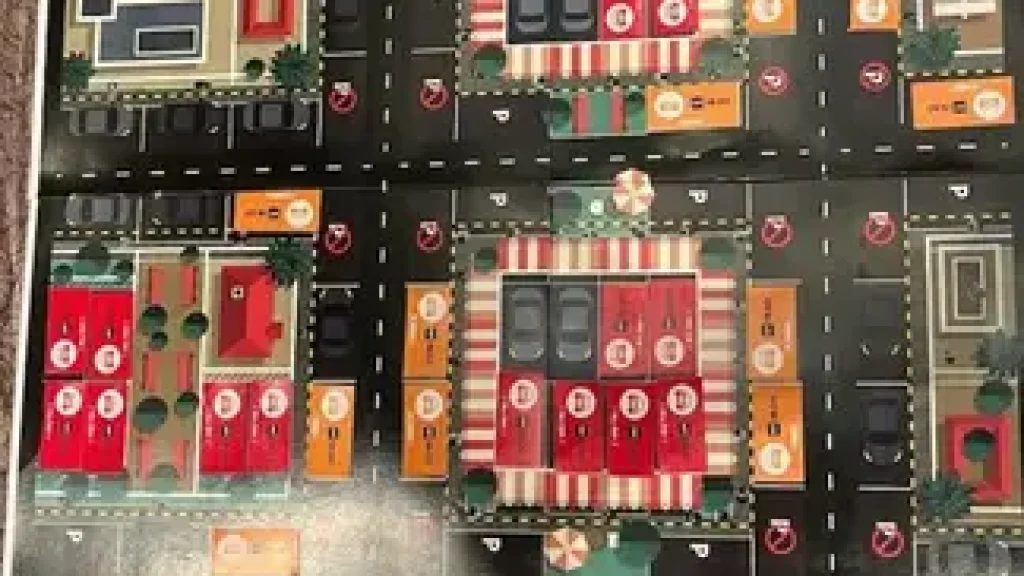
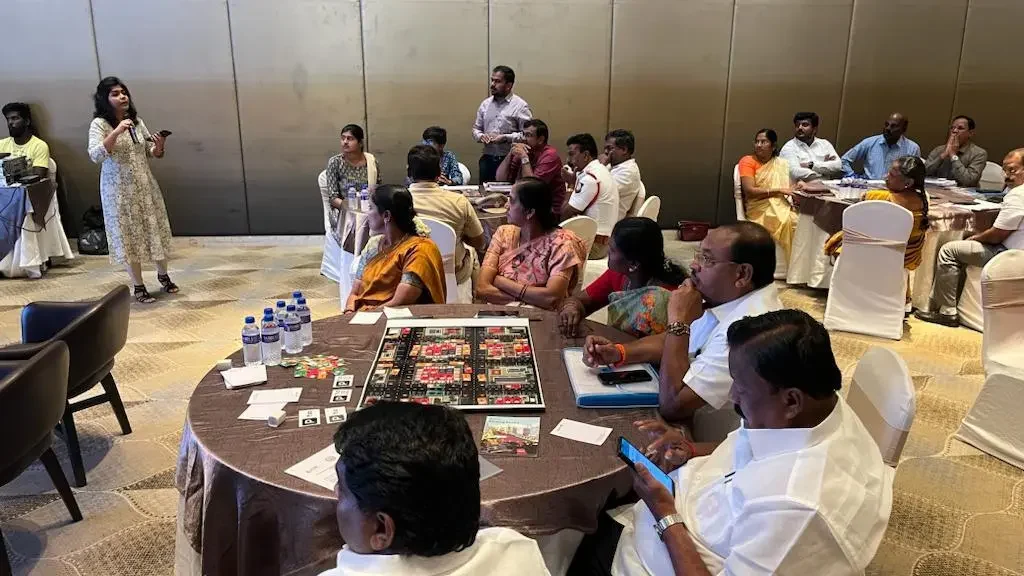
We studied these games to inform the development of our game and noticed some common desirable elements:
- Ensuring collaboration and participation – It is important to get participants to debate and discuss their ideas as they take key decisions together for a particular context.
- Playing the game in smaller groups – While playing in large groups, the voices of some players may not be heard. Smaller groups may help all players can have an equal opportunity to participate.
- Creating space for players to add ideas – A new and innovative idea may come from anyone, and space to add their own ideas could lead players to be more actively involved in the game.
Keeping these learnings in mind, we started brainstorming to develop our new game.
Structuring our game
We wanted to build a game that can help city officials quickly identify clear actions they can take in a three-year period towards creating Healthy Streets in their cities. We also wanted them to understand the importance of updating this action plan at the end of every three years. This clarity helped us develop the format of the game:
- The game would be set in a fictional city of ‘Malgudi’ for which the participants would develop an action plan to create Healthy Streets.
- Each team was handed a context card to help understand the setting better—with details about the city and its previous Healthy Streets initiatives.
- The game was to be played in three rounds, each round representing a year.
- In each round, participants would choose a certain number of actions the city would take from a variety of options, with a clear reasoning for each of them.
- After each round, the participants would be given information to help them evaluate the actions they chose and inform their selection in the next round.
Getting to the details
Now, getting to the main part—detailing the game. We curated the game keeping five principles in mind:
1. Design the game to be simple enough to be understood and played quickly – For the participants to quickly grasp the game and use the time to have meaningful conversations, we designed it as a card-based game. We also focused on simplifying the design of the cards, making sure the information on the cards is brief, clear, and actionable.
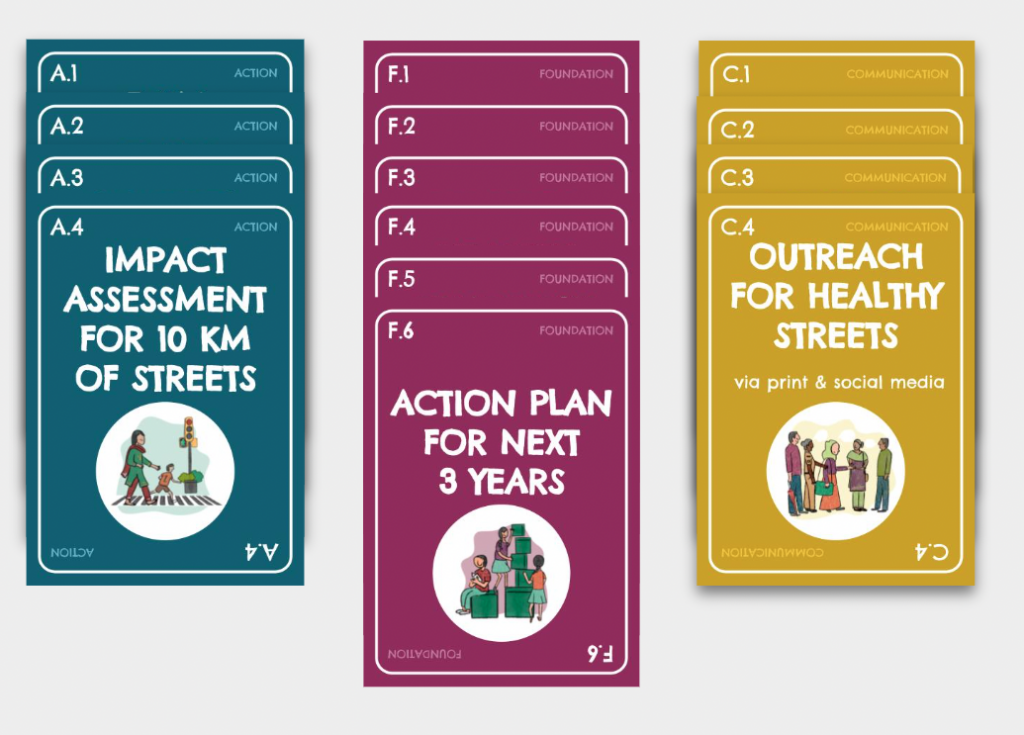
2. Identify the key messages you want the participants to take away from the game – We wanted the participants to understand the goals they are setting and how to prioritise them in each round. The game play and the instructions were designed to ensure they received this information clearly after each round.
3. Create the space for players to make not-so-great decisions and learn from them – We wanted the participants to make “mistakes” but also give them an opportunity to learn from them and fix them in the next rounds.
4. Design the game to have no winners to reinforce that there is no right or wrong final outcome – The overall outcome was to create a three-year action plan to create Healthy Streets. The goal was to get the participants to develop their own action plans based on solid reasoning, not to get all of them to develop the same “right” plan!
5. Add an element of fun and excitement for the players – Who doesn’t like to have some fun while playing the game? We tried to find ways to get the participants excited about the game by using GIFs to simplify and explain the game rules in an engaging way and by adding bonus cards—blank cards for the participants to add their own out-of-the-box ideas to the game—that they could earn through the rounds!
The game’s playing cards deck
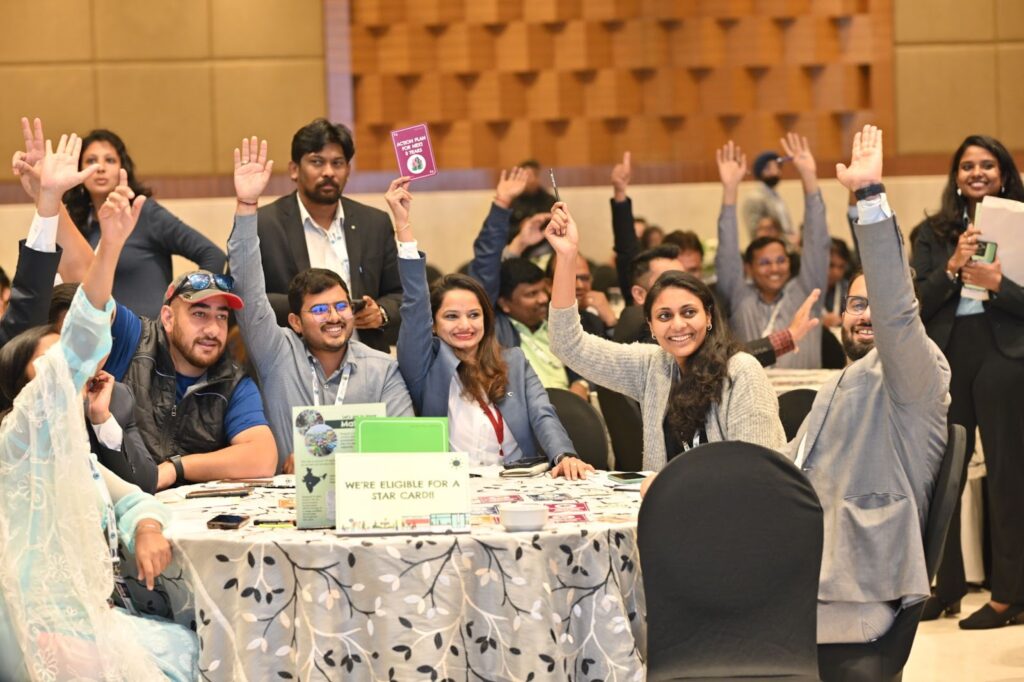
Finally, playing the game
20th Dec 2022, D-Day.
2 hours with 100+ city officials from 38 cities across the country.
We split the participants into teams of 10, with each team supported by a table moderator from our team. We had two facilitators who took the stage and introduced the entire game to the participants, and moderators for each table who helped the teams navigate the game. And then, the game began!
Teams excited about being eligible for bonus cards
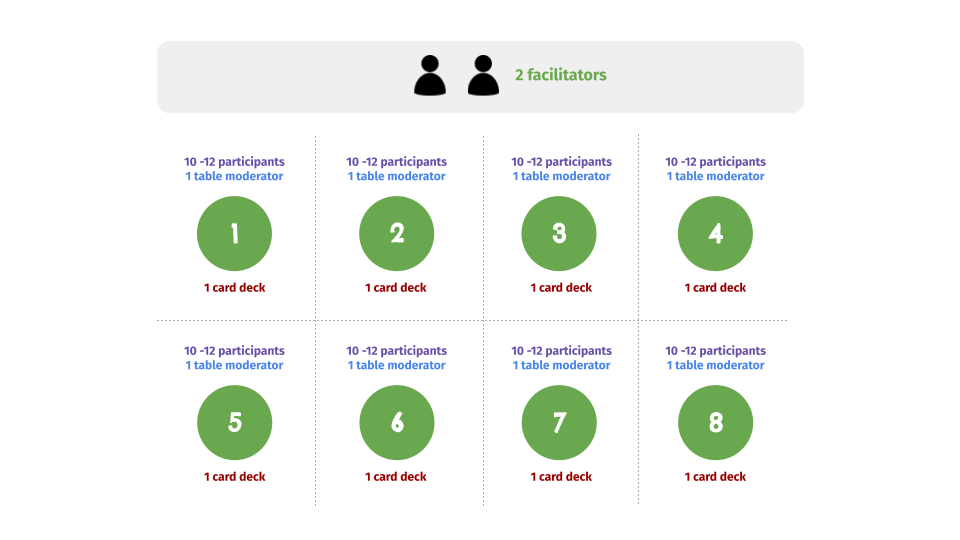
We were amazed to see that the format enabled them to jump right into the game, excited to figure out the action plans! The playful nature of the game brought out the child in the participants—including senior city officials—and we also witnessed participants excited not just to participate, but to debate and decide together, and also share their thought processes with the other teams—allowing their peers to also benefit from these insights.
Game room arrangement
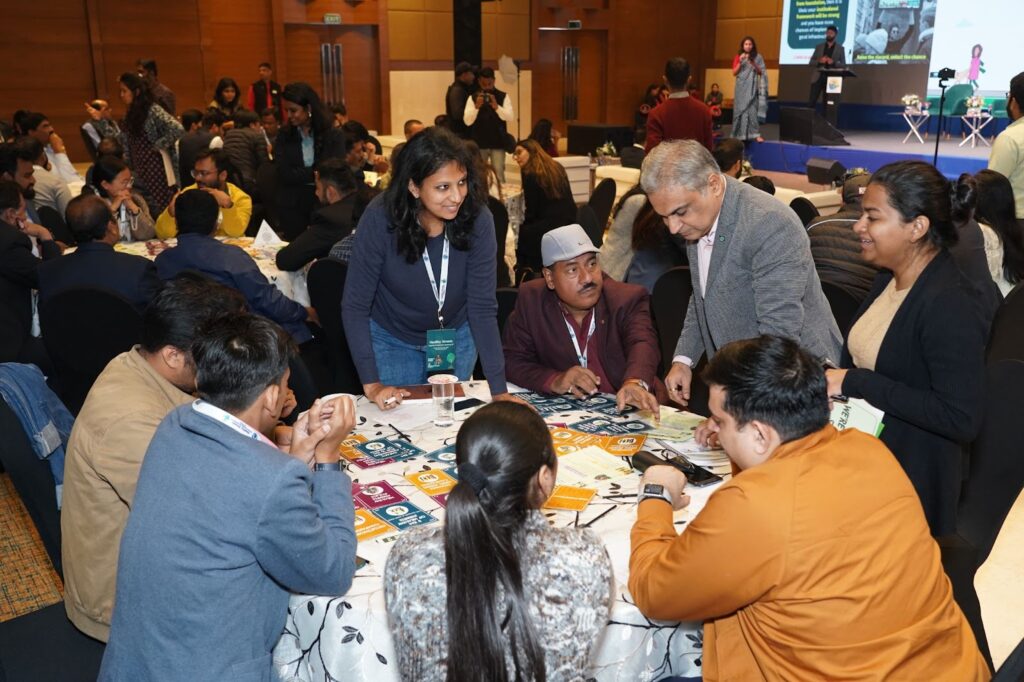
Teams in the process of selecting their cards in a round
Few more glimpses of the game being played by the participants
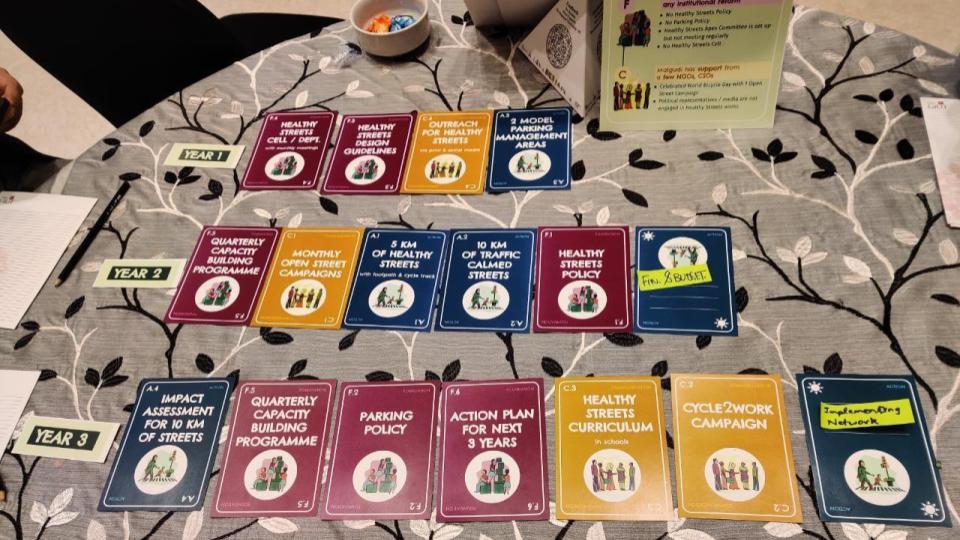
A completed Healthy Streets Action plan displayed by one of the teams
Way Forward
We hope the game will be a starting point for the cities to create robust and adaptive Healthy Streets Action Plans—living documents that evolve with the city in response to the needs of its citizens.
Similarly, we want the game to evolve based on learnings from tests and feedback from the city officials who engage with it. As we move forward, we hope to keep building on the game—adding layers of real-world complexities into the game by including specific aspects of the urban decision-making process like budgeting and participatory planning—without losing sight of the principles we started designing it with.
As more Indian cities move towards creating Healthy Streets and embracing sustainable transport, we are certain that games can play a strong role in their learning journey. As we improve this game and develop new ones, we also look forward to supporting other organisations interested in developing or testing similar games for sustainable urban development.
Happy gaming!
Recent Blogs
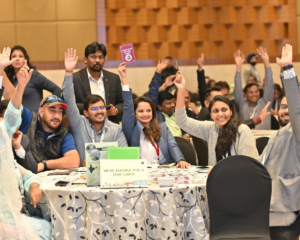
Learning from Play: How to design an urban transport game?

